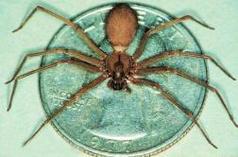
Understanding the Brown Recluse Spider
The brown recluse spider, also known as the fiddleback spider, is a venomous arachnid native to the southeastern United States. Its bite can cause a range of symptoms, from mild to severe, depending on the individual’s immune response. If you suspect you’ve been bitten by a brown recluse, it’s crucial to recognize the symptoms and seek medical attention promptly.
Identifying the Spider
Before delving into the symptoms of a brown recluse bite, it’s essential to be able to identify the spider itself. Brown recluse spiders are easily recognizable by their dark brown color, violin-shaped marking on the back, and long, thin legs. They are typically about the size of a quarter and prefer to hide in dark, undisturbed areas such as basements, attics, and closets.
Immediate Symptoms
The initial symptoms of a brown recluse bite may not be immediately apparent. However, some individuals may experience the following within a few hours to a day after the bite:
-
Redness and swelling at the bite site
-
Pain, which may be mild at first but can become severe
-
Itching
Delayed Symptoms
In some cases, symptoms may not appear for several days to a few weeks after the bite. These delayed symptoms can include:
-
Wound breakdown and necrosis (tissue death)
-
Ulceration at the bite site
-
Systemic symptoms, such as fever, chills, and nausea

Severity of Symptoms
The severity of symptoms can vary widely among individuals. Some people may experience only mild symptoms, while others may develop a severe reaction. Factors that can influence the severity of symptoms include:
-
Age: Children and the elderly are more susceptible to severe reactions
-
Immune system: Individuals with weakened immune systems may experience more severe symptoms
-
Number of bites: Multiple bites can increase the risk of a severe reaction
Diagnosis
Diagnosing a brown recluse bite can be challenging, as the symptoms can be similar to those of other spider bites and skin infections. However, healthcare providers may consider the following factors to make a diagnosis:
-
History of a spider bite
-
Characteristics of the bite site, such as redness, swelling, and ulceration
-
Presence of a necrotic wound
-
Results of laboratory tests, such as a skin biopsy or blood tests
Treatment
Treatment for a brown recluse bite typically involves:
-
Washing the bite site with soap and water
-
Applying a cool, wet compress to reduce swelling
-
Antibiotics to prevent infection
-
Topical or oral steroids to reduce inflammation
In severe cases, additional treatments may be necessary, such as:
-
Debridement (surgical removal of dead tissue)
-
Antivenom (in some cases)
Prevention
To reduce the risk of a brown recluse bite, consider the following precautions:
-
Keep your home clean and clutter-free
-
Seal cracks and crevices in your home
-
Use a vacuum cleaner to remove spiders from your home
-
Wear gloves when handling items in dark, undisturbed areas
Table: Comparison of Brown Recluse Bite Symptoms
| Immediate Symptoms | Delayed Symptoms |
|---|---|
| Redness and swelling at the bite site | Wound breakdown and necrosis |







